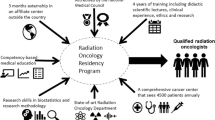Abstract
Purpose of Review
Radiologic-pathologic concordance is the review of a patient’s breast imaging in the context of his/her pathology results and is a critical and unique component of breast imaging and diagnosis. Our goal is to develop a structured curriculum that prepares residents and fellows to analyze radiologic-pathologic concordance critical to patient management and improved patient outcomes.
Recent Findings
To our knowledge, there is no formalized academic educational program to teach radiologic-pathologic concordance. To address this gap for our diagnostic radiology residents and fellows, we developed, in coordination with our breast pathology department, a standardized educational curriculum for radiologic-pathologic correlation based on the American College of Radiology and Society of Breast Imaging Resident and Fellowship Training Curriculum Monticciolo DL, Rebner M, Appleton CM, Newell MS, Farria DM, Sickles EA et al. (J Am Coll Radiol 10(3):207–10.e4, 1). This curriculum also includes normal breast development and unique pathology for different patient populations.
Summary
The process of evaluating radiologic-pathologic concordance in breast imaging is essential, particularly after minimally invasive breast procedures to identify potentially discordant pathology results that require further action and concordant results that may need further management. Breast imagers traditionally teach residents and fellows this process primarily at the monitor as pathology results return and during periodic joint conferences with pathology colleagues. This leaves potential gaps of knowledge as trainees’ experience is dependent on the types of pathology results returning while they are on rotation and if they are available when this process occurs. The absence of a standardized curriculum makes it challenging to learn or review this material and track its acquisition. The creation of a standardized curriculum and an educational journal series should enhance the uniformity of trainees’ experiences with regard to this important topic. The purpose of this publication is to introduce the curriculum and describe topics covered in the first module, including normal breast histology, gross anatomy, development, alterations during the menstrual cycle, and the male breast.









Similar content being viewed by others
References
Monticciolo DL, Rebner M, Appleton CM, Newell MS, Farria DM, Sickles EA, et al. The ACR/Society of Breast Imaging Resident and fellowship training curriculum for breast imaging, updated. J Am Coll Radiol. 2013;10(3):207-10.e4. https://doi.org/10.1016/j.jacr.2012.07.026.
Owen CI. Radiology and pathology. Radiology. 1932;18(1):149–51. https://doi.org/10.1148/18.1.149.
Geddes DT. Inside the lactating breast: the latest anatomy research. J Midwifery Womens Health. 2007;52(6):556–63. https://doi.org/10.1016/j.jmwh.2007.05.004.
Gray’s anatomy: the anatomical basis of clinical practice / editor-in-chief, Susan Standring ; section editors, Neel Anand [and 12 others]. Forty-first edition. ed. Anatomy : the anatomical basis of clinical practice. Philadelphia: Elsevier Limited; 2016.
Hassiotou F, Geddes D. Anatomy of the human mammary gland: current status of knowledge. Clin Anat. 2013;26(1):29–48. https://doi.org/10.1002/ca.22165.
Jesinger RA, Lattin GE, Ballard EA, Zelasko SM, Glassman LM. Vascular abnormalities of the breast: arterial and venous disorders, vascular masses, and mimic lesions with radiologic-pathologic correlation. Radiographics: a review publication of the Radiological Society of North America, Inc. 2011;31(7):E117. doi:https://doi.org/10.1148/rg.317115503.
O’Malley FP, Pinder SE, Mulligan AM. Breast pathology. 2nd ed. Foundations in diagnostic pathology. Philadelphia: Elsevier/Saunders; 2011.
Dabbs DJ. Breast pathology. Philadelphia, PA: Elsevier/Saunders; 2012.
Cotran RS, Kumar V, Collins T, Robbins SL. Robbins pathologic basis of disease. 6th ed. Philadelphia: Saunders; 1999.
Carlson BM. Human embryology and developmental biology. Sixth edition. ed. St. Louis, Mo.: St. Louis, Mo. : Elsevier; 2019.
Author information
Authors and Affiliations
Corresponding author
Ethics declarations
Human and Animal Rights and Consent to Participate
This article does not contain any studies with human or animal subjects performed by any of the authors.
Conflict of Interest
Scott Zelasko, Brittany O’Steen, Elizabeth Parker, and Mark Kilgore declare that they have no conflict of interest. John Scheel reports grants from GE Healthcare and the Radiological Society of North America to support research outside the submitted work.
Additional information
Publisher's Note
Springer Nature remains neutral with regard to jurisdictional claims in published maps and institutional affiliations.
This article is part of the Topical Collection on Best Practice Approaches Breast Radiology-Pathology Correlation and Management
Rights and permissions
About this article
Cite this article
Zelasko, S.M., O’Steen, B., Parker, E. et al. Formalized Radiologic-Pathologic Curriculum in Breast Imaging for Breast Imaging Fellows and Residents: how we do it. Curr Breast Cancer Rep 13, 405–413 (2021). https://doi.org/10.1007/s12609-021-00440-0
Accepted:
Published:
Issue Date:
DOI: https://doi.org/10.1007/s12609-021-00440-0




